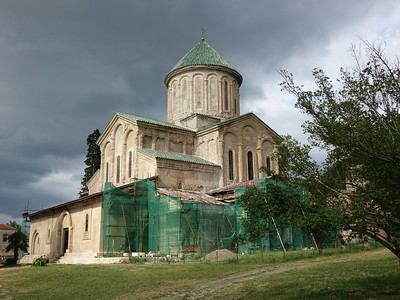Gelati Monastery

Gelati Monastery is a medieval Orthodox monastery that is considered the masterpiece of the architecture of the “Golden Age” of Georgia.
The architecture is characterized by large blocks and the use of blind arches. In the monastery and its churches, great numbers of medieval mosaics, murals and manuscripts have been preserved. The complex was also one of the country’s main cultural and educational centers.
Community Perspective: the earlier reviews still mention the Bagrati Cathedral, with which Gelati shared its inscription until the former was delisted in 2017. Els did the most recent comprehensive review of a visit to the Gelati Monastery from Kutaisi.


Map of Gelati Monastery
Community Reviews
Els Slots

Since the retreat of the controversial Bagrati Cathedral, Gelati Monastery can shine in its own right. And what a sight this is. Its wall paintings are overwhelming and intriguing at the same time, because the depicted people far exceed the average list of Christian holy figures. They show saints and historical figures from Georgia and the Byzantine empire in their most beautiful clothing.
The 12th-century Gelati Monastery dates back to the Golden Age of medieval Georgia. The complex consists of 3 churches, a free-standing bell tower and an academy building. It was for a long time the cultural center of Georgia, with its own academy where the best scientists, theologians and philosophers worked.
From the center of Kutaisi, a minibus leaves 5 times a day directly to this monastery. It starts from a small parking lot with some other local minibusses at the back of Meskhishvili Theatre. The ride costs 1 lari (0.30 EUR). The 4 pm bus that I took only transported women: a few living along the route who had gone shopping in the city, another tourist and me. We two were the only ones that remained on the bus til the end. You can already see the monastery from a distance, on a hill amongst the greenery. The drive takes only a short 20 minutes.
The complex has the (for Georgia) usual set of souvenir and snack stalls in the parking lot. A small courtyard contains the 3 churches, the bell tower and the academy building. I immediately went to the main church. Its interior is covered with murals over the entire surface. There are innumerable scenes and portraits, clearly made in different periods. I was happy that I brought my Bradt travel guide with me: in its 2-page description of the Monastery, the names of the most prominent persons depicted are given.
Above the altar in the dome, there is a golden mosaic of Mary with Child - a Byzantine-inspired mosaic that is unique in Georgia.
There is more to see at the corners of the courtyard. The south gate for example contains the tomb of David 'the Builder' - the 12th-century king who founded this monastery and many other important buildings in the Golden Age of Georgia. Everyone who left the monastery had to walk over his grave. The remains of an 11th-century iron door from Persia are still hanging in the gate, once taken back to Georgia by David's son as war booty.
Of the 2 smaller churches, St. George is the most beautiful. Just like with the big church they are restoring its exterior and it is partly covered in scaffoldings. You can not enter it (it is reportedly only open at weekends and is often used for marriage ceremonies). But the doors leave an opening through which you can see the inside: this is perhaps an even bigger wall painting than the main church. A lot of bright red and blue have been used.
The minibus schedule allows one to have 1 hour at the Monastery, which is really too little. I spent about 1.5 hours there and waited for the last bus of the day (6.20 pm) to bring me back to Kutaisi. Distance wise this is walkable as well as it is 8km, but there are one or two nasty climbs en route.
Read more from Els Slots here.
Verena Gautschi
Lucerne, Switzerland - 17-Oct-13 -
Our group from Switzerland visited both places this September. We were happy to see that Bagrati Cathedral shows no more outward signs of damage. We were even spontaneously given a little concert of Georgian songs by four men in traditional costumes.
As for Gelati Monastery, it was a great joy that the academy building was completely restored, including a solid roof. So it was easy to picture the academic life of those times.
Alfons and Riki Verstraeten
After visiting Azerbeidzjan, we continued our trip to Georgia. Wonderful Mtskheta and in Kutaisi: Bagrati Cathedral and Gelati Monastery. The construction inside Bagrati Cathedral to restore the building is perfect, but outside, left from the entrance it is awful
Irene Kopaliani
We've visited Bagrati Cathedral yesterday. The restoration process is coming full force, transforming the building. During my last visit, the church had no roof. Now, the roof is done and building is almost reconstructed. I really enjoyed the "original" no roof look. Now, it looks just like any other church in the area.
Warren Dent
Bagrati Cathedral was a beautiful experience. Our church plans a mission trip every year to the Republic of Georgia to help out orphanges and we always visit Bagrati Cathedral because it is such a beautiful place. We do not have anything like this in the USA. I was so impressed with the architecture and at night our group went up there at sunset and we took candles because there is no electricity. What an awsome experience. We met many native Georgians that night and made many new friends. This will be a place we will always return to because of the many wonderful memories there. I found this quote that I thought was very fitting to Bagrati.
C. S. Lewis once said “that all churches should be roofless, for this very reason: worshipers would be overcome by the world God has fashioned rather than shut up in their man-made boxes.”
Warren Dent
Atlanta, Georgia
Solivagant

The “double headed” WHS of “Bagrati Cathedral and Gelati Monastery” consists of a ruined (in 1691 by the Turks) Cathedral of the 10th to 11th centuries in the town of Kutaisi and a (still functioning) monastery complex built between the 12th to 17 centuries situated in the countryside some 12kms away.
Apart from the geographical proximity and the fact that, taken together, the 2 buildings represent a long and continuous period of Georgian religious architecture, I know of no reason why they are linked together in a single WHS.
Even in “shell” form the cathedral is an enormous building. It is named after Bagrat III the first king of united Georgia and is no doubt of considerable architectural interest. I also understand the comments made by another reviewer about the open roof not necessarily detracting from its religious impact (UNESCO has severely criticised the idea, apparently floated in the early 90’s, presumably as some sort of “Georgian independence celebration”, of rebuilding the Cathedral!). I however did not find the building and its setting particularly inspiring.
I personally far preferred the Gelati complex. It is beautifully set in countryside of woods and fields of greenest hue. A stream runs through the grounds and the ensemble of 2 main buildings complement each other superbly. The interior contains many fine mosaics and frescos. We had the place to ourselves. (Visited Aug 2000)
Community Rating
- : Walter Serimari Milan Jirasek Filip Murlak Fmaiolo@yahoo.com Roccobot
- : Tarquinio_Superbo WalGra
- : Stanislaw Warwas Tony H. BH Paolosan82 Voyager Christravelblog StaziG Christoph Marton Kemeny
- : Els Slots Jungliemonkey CugelVance Rodinia JoStof GatorTravel Mahuhe Luke LOU Kevin McFarland WestcountryWanderer Daniel C-Hazard
- : D.dedisse@vogo.fr Kurt Lauer Nan Aljaz Can SARICA Javier Philipp Leu Alikander99 JobStopar Martina Rúčková Ivan Rucek
- : Solivagant Janis Zoë Sheng Jon Opol Wojciech Fedoruk
- : Kristin Dorejd Roman Raab
- : Merveil
- : Yevhen Ivanovych
Site Info
Site History
2017 Boundary change
Bagrati Cathedral removed
2017 Removed from Danger list
After excluding Bagrati Cathedral, which has undergone major reconstruction detrimental to its integrity and authenticity.
2015 Referred
Major Boundary Modification referred, where Bagrati Cathedral would be delisted and Gelati Monastery was renominated on its own
2010 In Danger
"The Committee expressed its serious concern about irreversible interventions carried out on the site as part of a major reconstruction project. The Committee believes this project will undermine the integrity and authenticity of the site and should be immediately halted." (unesco)
1994 Inscribed
Site Links
Unesco Website
Official Website
Related
In the News
Connections
The site has 18 connections
Art and Architecture
Constructions
Geography
Science and Technology
Timeline
Trivia
Visiting conditions
WHS on Other Lists
World Heritage Process
Visitors
203 Community Members have visited.
The Plaque